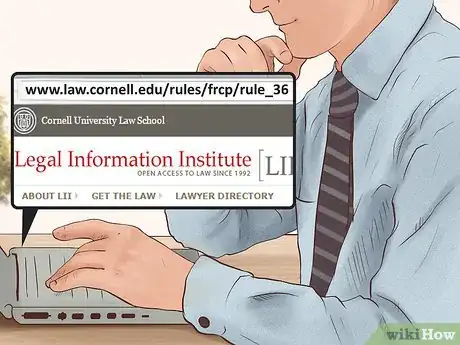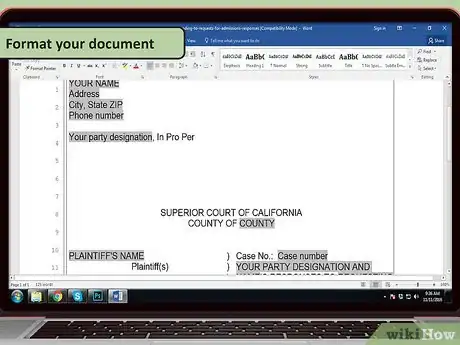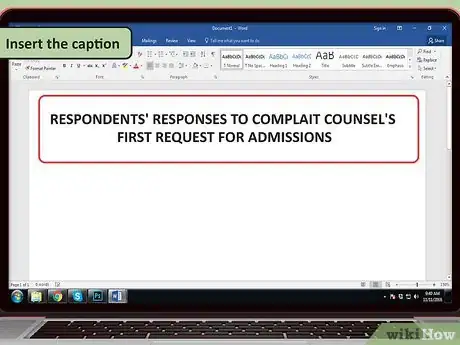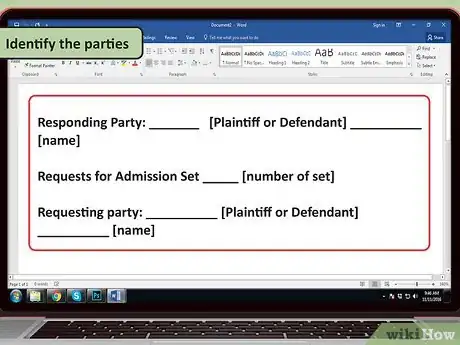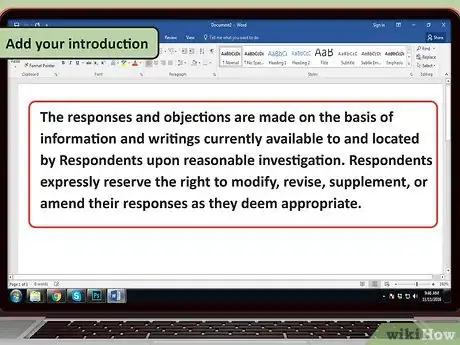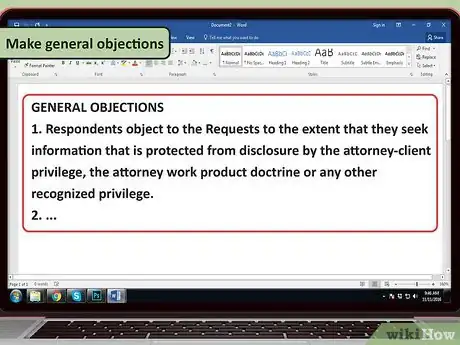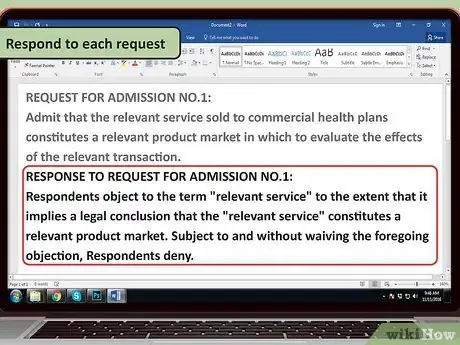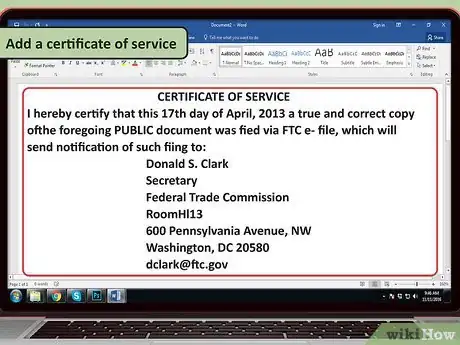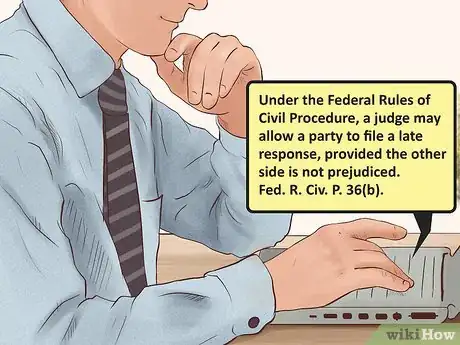This article was co-authored by Clinton M. Sandvick, JD, PhD. Clinton M. Sandvick worked as a civil litigator in California for over 7 years. He received his JD from the University of Wisconsin-Madison in 1998 and his PhD in American History from the University of Oregon in 2013.
There are 7 references cited in this article, which can be found at the bottom of the page.
This article has been viewed 38,642 times.
It is critical that you answer Request for Admissions promptly and adequately. As soon as you receive the Request, you should read it and begin drafting your answers. If you miss the deadline for responding, then the judge might deem the requests as admitted, which almost surely will lead to you losing the lawsuit. To make sure that your answers comply with the law, read your relevant Rule of Civil Procedure before beginning your answers.
Steps
Answering the Request for Admissions
-
1Find your deadline for responding. You can’t miss the deadline for responding to the requests, so you should quickly find how much time you have to respond. Look at your Rules of Civil Procedure and find the rule on requests for admission.
- If you are in federal court, then Federal Rule 36 is the relevant rule.[1]
- If you are in state court, then the rule will depend on your state’s rules of civil procedure, which you can find online.
- The judge might also have changed the deadline. You should look through your notes or read the local rules, which you can get from the judge’s chambers or the court’s website.
-
2Read the requests. Go through each request individually and write down notes beside each one. You need to admit or deny each request. In some situations, you may also claim that you can’t truthfully admit or deny because you don’t know the answer after performing a diligent search for the answer.[2]
- If part of the request is true, then you will need to identify the part that is true. Likewise, if part of the request is false, then you also will need to identify which part is false.
- Don’t deny all requests in a blanket fashion. The judge could sanction you.
Advertisement -
3Format your document. When you are ready to draft your answers, you should open a blank word processing document. Format it so that it resembles the other documents you filed in your case.
- You may have to print on pleading paper, which is paper numbered down the left-hand side.[3] Remember to leave a large enough margin to account for the numbering.
-
4Insert the caption. The caption includes the name of your court, the names of the parties, and the case number. It might also include the judge’s name. You can get this information from any document filed in your case. Insert the caption at the top of the page.
- Also title the document. You can title it “Respondent’s Response to Plaintiff’s First Request for Admissions” or something similar.[4]
-
5Identify the parties. In some states, such as California, you need to identify the parties immediately under the title. You should insert the following information:
- The Propounding Party: this is the party that served the Request for Admissions.
- The Responding Party: this is you.
- Set Number: the number of requests.
-
6Add your introduction. In your introduction, briefly identify yourself. You can also include some legal boilerplate that is meant to protect you. For example, you could write:[5]
- No incidental or implied admissions are intended by these responses.
- The fact that you have responded to a request does not mean you intend to waive any objection that you have to the request.
- Your responses and objections are based on the information and documents currently available to you after reasonable investigation.
- You reserve the right to supplement or revise your answers at a later date.
-
7Make general objections. Before answering each individual request, you can list general objections. These objections will apply to all of the requests. You can add them under the heading “General Objections” and number them. Common general objections include:[6]
- Respondent objects to the Requests to the extent they seek information protected by attorney-client privilege, the attorney work product doctrine, or other recognized privileges.
- Respondent objects to the Requests to the extent they require search for and the production of documents or information not in Respondent’s custody, possession, or control.
- Respondent objects to the Requests to the extent they seek legal conclusions or would require Respondent to reach a legal conclusion in order to prepare a response.
- Respondent objects to the Requests to the extent they are argumentative, improper, incorrect, prejudicial, vague, and/or ambiguous.
- Respondent objects to the Requests to the extent they seek information that Respondent cannot locate after diligent inquiry, are readily available from public sources, or are available to Counsel from another source that is more appropriate, convenient, less burdensome, and/or less expensive.
-
8Respond to each request. Respond in the order they were presented to you. In some states, you need to repeat the request before answering. You need to be as accurate as possible when responding to each request. Admit, deny, or claim insufficient knowledge to admit or deny. However, instead of answering certain requests, you could raise a relevant objection:[7]
- The request is compound. Each request should contain only one statement. If a requests asks you to admit two or more facts, then you should object that it is compound.
- The request is vague, unintelligible, or ambiguous. You can object if you don’t understand the request. For example, “Admit you owned the gun” is vague because it does not refer to a specific gun.
- The request is not reasonably calculated to lead to the discovery of relevant, admissible evidence. This is a long way of saying the request is a waste of time because the fact isn’t relevant to your case. For example, asking you to admit that you weigh 200 pounds is irrelevant if your case has nothing to do with your weight.
-
9Sign the document. Add a signature block at the bottom of the document. You don’t need a conclusion, so insert the signature block right after your final answer. Also add the date.[8]
- In some states, you will have to sign your answers under penalty of perjury. Read your relevant Rule of Civil Procedure to check. Sample language could read: “I declare under penalty of perjury under the laws of the State of [insert state] the foregoing answers are true and correct.”
Serving Your Answers
-
1Add a certificate of service. You need to certify that you served your answers to the other side. You should add a certificate of service on a separate piece of paper and include the person you sent the answers to as well as the delivery method (e.g., regular mail, hand delivery, fax, etc.)
- Look at the certificate of service attached to the Request for Admissions to find helpful language.
-
2Make copies. Once you finish, you should make several copies of your answers. Keep one copy for your records. You can send the original to the other party.
- There may be additional parties to your lawsuit. For example, you might be one of three defendants. If the plaintiff sends you the Request for Admissions, you should send copies of your answers to the other two defendants.[9]
-
3Serve your answers. You need to serve your answers on the lawyer of the party who sent you the Request.[10] Generally, you can serve the answers by having someone 18 or older who is not related to the case mail them for you.
- In federal court, you might be able to serve the answers by filing them electronically with the court.[11] The other parties get notified electronically when they are filed.
-
4Get a signed proof of service. Your server may have to fill out a Proof of Service form instead of a certificate of service. The server completes the form and then signs it in front of a notary.
- You can ask the court clerk whether or not this form needs to be signed.
Responding After Missing the Deadline
-
1Read the motion. If you missed the deadline for answering the Request for Admissions, then the other side can file a motion with the judge asking that the facts be deemed admitted as conclusively proven. This motion may be called “Motion to Have Admissions Deemed Admitted” or something similar.[12] This means that the judge will consider the admissions to be true even if they aren’t, and you won’t be able to present evidence to the contrary.
- Missing the deadline for responding is a serious problem. Once you get the motion, you should immediately find your copy of the original Request for Admissions. A copy may be attached to the motion.
-
2Meet with an attorney. Get a referral to a qualified attorney and schedule a meeting quickly. You want to understand what your options are if you missed the deadline for responding to the Request.
- You can find a qualified attorney by visiting your state or local bar association and asking for a referral. Call up the attorney and ask how much he or she charges.
- If money is tight, then you can try to find legal aid. Legal aid provides free legal services to people in financial need. You can find the nearest legal aid office by visiting the Legal Services Corporation’s website and clicking on “Find Legal Aid.”[13]
-
3Answer the Request for Admissions. In some states, you can prevent the judge from deeming the requests admitted if you promptly answer the Request for Admissions before the scheduled hearing date. In that situation, the hearing will fall off the judge’s calendar.
- If this is an option, then quickly respond to the Request.
- You may still have to pay for the other side’s court costs, such as the amount spent filing the motion. You could also be sanctioned by being ordered to pay the other side’s attorneys’ fees spent on filing the motion. Nevertheless, these are small prices to pay.
-
4File a motion in opposition. You can try to prevent the judge from deeming the admissions true by filing a motion explaining why you didn’t answer in a timely manner. You should set up the motion as you would other motions filed in your case. You need to give the judge a good reason why you couldn’t answer the requests for admission in time.
- Read your relevant Rule of Civil Procedure. Generally, these rules allow the judge to give you a chance to respond late if the other party wouldn’t be prejudiced.[14] You should remind the judge of that fact. For example, you could write: “Under the Federal Rules of Civil Procedure, a judge may allow a party to file a late response, provided the other side is not prejudiced. Fed. R. Civ. P. 36(b).”
- Also do legal research. Many courts prefer that lawsuits be decided on the merits and not because one party was late responding to requests for admission. You should find a case from your jurisdiction which stands for this proposition and then quote from it. You can find cases in Google Scholar under “Case law.”[15]
- File the motion with the court and send a copy to the other side.
References
- ↑ https://www.law.cornell.edu/rules/frcp/rule_36
- ↑ https://saclaw.org/wp-content/uploads/sbs-discovery-reponding-to-requests-for-admission.pdf
- ↑ https://saclaw.org/wp-content/uploads/sbs-discovery-reponding-to-requests-for-admission.pdf
- ↑ https://www.ftc.gov/sites/default/files/documents/cases/2013/04/130417respccreqadmin.pdf
- ↑ https://www.ftc.gov/sites/default/files/documents/cases/2013/04/130417respccreqadmin.pdf
- ↑ https://www.ftc.gov/sites/default/files/documents/cases/2013/04/130417respccreqadmin.pdf
- ↑ https://saclaw.org/wp-content/uploads/sbs-discovery-reponding-to-requests-for-admission.pdf
- ↑ https://www.ftc.gov/sites/default/files/documents/cases/2013/04/130417respccreqadmin.pdf
- ↑ https://saclaw.org/wp-content/uploads/sbs-discovery-reponding-to-requests-for-admission.pdf
- ↑ https://saclaw.org/wp-content/uploads/sbs-discovery-reponding-to-requests-for-admission.pdf
- ↑ https://www.ftc.gov/sites/default/files/documents/cases/2013/04/130417respccreqadmin.pdf
- ↑ http://www.parentaldefense.org/File/672de1f2-1a13-47f4-9f67-c02b567def79
- ↑ http://www.lsc.gov/
- ↑ https://www.law.cornell.edu/rules/frcp/rule_36
- ↑ https://scholar.google.com/
